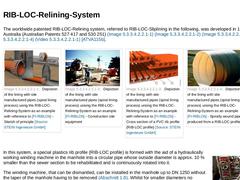
|
The worldwide patented RIB-LOC-Relining system, referred to RIB-LOC-Sliplining in the following, was developed in 1984 in Australia (Australian Patents 527 417 and 530 251) (Bild 5.3.2.3.1.1) (Bild 5.3.2.3.1.1) (Bild 5.3.2.3.1.1) (Bild 5.3.2.3.1.1) (Abschnitt 5.3.2.3.1.1) [ATVA115b]. | (Image: Depiction of the lining with site manufactured pipes (spiral lining process) using the RIB-LOC-Relining-System as an example with reference to [FI-RIBLOb] - … |
|
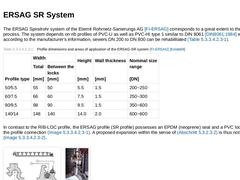
|
The ERSAG Spiralrohr system of the Eternit Rohrnetz-Sanierungs AG [FI-ERSAG] corresponds to a great extent to the RIB-LOC process. The system depends on rib profiles of PVC-U as well as PVC-HI type 1 similar to DIN 8061 [DIN8061:1984] with which, according to the manufacturer's information, sewers DN 200 to DN 800 can be rehabilitated (Tabelle 5.3.2.3.1.2). (Table: Profile dimensions and areas of application of the ERSAG-SR system [FI-ERSAG] [Kelda88]) |
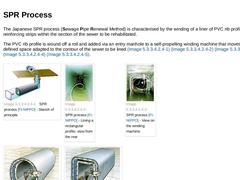
|
The Japanese SPR process (Sewage Pipe Renewal Method) is characterised by the winding of a liner of PVC rib profiles with steel reinforcing strips within the section of the sewer to be rehabilitated. The PVC rib profile is wound off a roll and added via an entry manhole to a self-propelling winding machine that moves along an defined space adapted to the contour of the sewer to be lined (Bild 5.3.2.3.1.3) (Bild 5.3.2.3.1.3) (Bild 5.3.2.3.1.3) (Bild … |
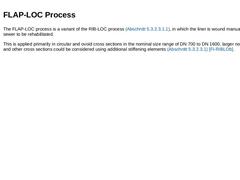
|
The FLAP-LOC process is a variant of the RIB-LOC process (Abschnitt 5.3.2.3.1.1), in which the liner is wound manually into the sewer to be rehabilitated. This is applied primarily in circular and ovoid cross sections in the nominal size range of DN 700 to DN 1600, larger nominal sizes and other cross sections could be considered using additional stiffening elements (Abschnitt 5.3.2.3.1) [FI-RIBLOb]. |
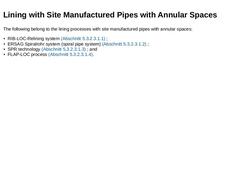
|
The following belong to the lining processes with site manufactured pipes with annular spaces: - RIB-LOC-Relining system (Abschnitt 5.3.2.3.1.1) ;
- ERSAG Spiralrohr system (spiral pipe system) (Abschnitt 5.3.2.3.1.2) ;
- SPR technology (Abschnitt 5.3.2.3.1.3) ; and
- FLAP-LOC process (Abschnitt 5.3.2.3.1.4).
|
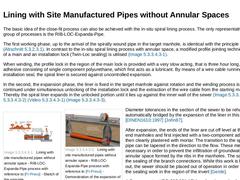
|
The basic idea of the close-fit process can also be achieved with the in-situ spiral lining process. The only representative of this group of processes is the RIB-LOC-Expanda-Pipe. The first working phase, up to the arrival of the spirally wound pipe in the target manhole, is identical with the principle described in Abschnitt 5.3.2.3.1. In contrast to the in-situ spiral lining process with annular space, a modified profile jointing technique consisting … |
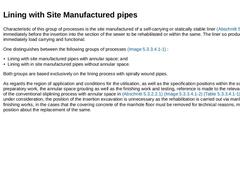
|
Characteristic of this group of processes is the site manufactured of a self-carrying or statically stable liner (Abschnitt 5.3.2.1) either immediately before the insertion into the section of the sewer to be rehabilitated or within the same. The liner so produced is immediately load carrying and functional. One distinguishes between the following groups of processes (Bild 5.3.2) : - Lining with site manufactured pipes with annular space; and
- Lining …
|
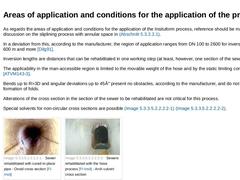
|
As regards the areas of application and conditions for the application of the Insituform process, reference should be made to the discussion on the sliplining process with annular space in Abschnitt 5.3.2.2.1. In a deviation from this, according to the manufacturer, the region of application ranges from DN 100 to 2600 for inversion lengths of 600 m and more [Dilg91]. Inversion lengths are distances that can be rehabilitated in one working step (at … |
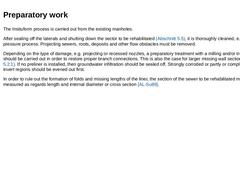
|
The Insituform process is carried out from the existing manholes. After sealing off the laterals and shutting down the sector to be rehabilitated (Abschnitt 5.5), it is thoroughly cleaned, e.g. with a high pressure process. Projecting sewers, roots, deposits and other flow obstacles must be removed. Depending on the type of damage, e.g. projecting or recessed nozzles, a preparatory treatment with a milling and/or trowel robot should be carried out … |
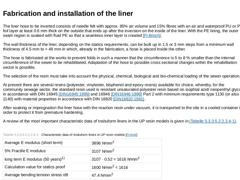
|
The liner hose to be inverted consists of needle felt with approx. 85% air volume and 15% fibres with an air and waterproof PU or PE foil layer at least 0.6 mm thick on the outside that ends up after the inversion on the inside of the liner. With the PE lining, the outer seam region is soaked with fluid PE so that a seamless inner layer is created [FI-Broch].
The wall thickness of the liner, depending on the statics requirements, can be built up … |
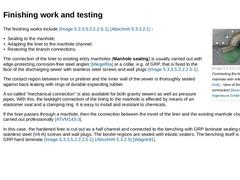
|
(Image: Connecting the liner into the entry manhole with reference to [FI-Insit] - View of the manhole connection [Image: S&P GmbH]) The finishing works include (Bild 5.3.2.4.1) (Abschnitt 5.3.2.2.1) : - Sealing to the manhole;
- Adapting the liner to the manhole channel;
- Restoring the branch connections.
The connection of the liner to existing entry manholes (Manhole sealing) is usually carried out with edge-protecting corrosion-free steel angles [Miege89a] … |
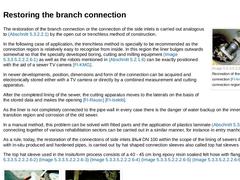
|
(Image: Recreation of the branch connection [FI-Insit] - Opening the connection region of the lateral) The restoration of the branch connection or the connection of the side inlets is carried out analogous to Abschnitt 5.3.2.2.1 by the open cut or trenchless method of construction. In the following case of application, the trenchless method is specially to be recommended as the connection region is relatively easy to recognise from inside. In this … |
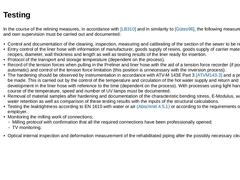
|
In the course of the relining measures, in accordance with [LB310] and in similarity to [Gütes96], the following measures for testing and own supervision must be carried out and documented: - Control and documentation of the cleaning, inspection, measuring and calibrating of the section of the sewer to be rehabilitated.
- Entry control of the liner hose with information of manufacturer, goods supply of resins, goods supply of carrier material, resin recipes, …
|
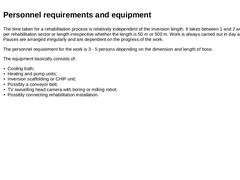
|
The time taken for a rehabilitation process is relatively independent of the inversion length. It takes between 1 and 2 working days per rehabilitation sector or length irrespective whether the length is 50 m or 500 m. Work is always carried out in day and night shifts. Pauses are arranged irregularly and are dependent on the progress of the work. The personnel requirement for the work is 3 - 5 persons depending on the dimension and length of hose. |
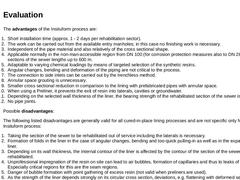
|
The advantages of the Insituform process are: - Short installation time (approx. 1 - 2 days per rehabilitation sector).
- The work can be carried out from the available entry manholes; in this case no finishing work is necessary.
- Independent of the pipe material and also relatively of the cross sectional shape.
- Applicable normally in the non-man-accessible region from DN 100 (for corrosion protection measures also to DN 2600) and sections of the sewer …
|
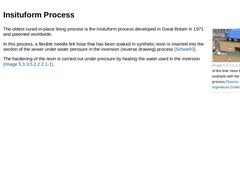
|
(Image: Insertion of the liner hose by means as an example with the Insituform process) The oldest cured-in-place lining process is the Insituform process developed in Great Britain in 1971 and patented worldwide. In this process, a flexible needle felt hose that has been soaked in synthetic resin is inserted into the section of the sewer under water pressure in the inversion (reverse drawing) process [Schwe93]. The hardening of the resin is carried … |
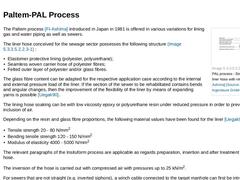
|
(Image: Paltem-PAL process - Structure of the liner hose with reference to [FI-Ashima] [Image: S&P GmbH]) The Paltem process [FI-Ashima] introduced in Japan in 1981 is offered in various variations for lining gas and water piping as well as sewers. The liner hose conceived for the sewage sector possesses the following structure (Bild 5.3.2.4.1.1.2) : - Elastomer protective lining (polyester, polyurethane);
- Seamless woven carrier hose of polyester fibres;
|
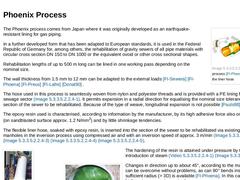
|
(Image: Phoenix process [FI-Phoenb] - Structure of the liner hose) The Phoenix process comes from Japan where it was originally developed as an earthquake-resistant lining for gas piping. In a further developed form that has been adapted to European standards, it is used in the Federal Republic of Germany for, among others, the rehabilitation of gravity sewers of all pipe materials with circular cross section DN 150 to DN 1000 or the equivalent ovoid … |
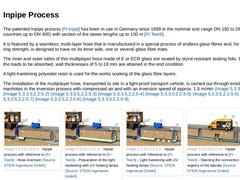
|
The patented Inpipe process [FI-Inpip] has been in use in Germany since 1989 in the nominal size range DN 150 to DN 300 (in other countries up to DN 400) with section of the sewer lengths up to 100 m [FI-Teerb]. It is featured by a seamless, multi-layer hose that is manufactured in a special process of endless glass fibres and, for increasing the ring strength, is designed to have on its inner side, one or several glass fibre mats. The inner and outer … |
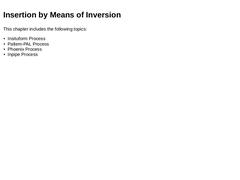
|
|
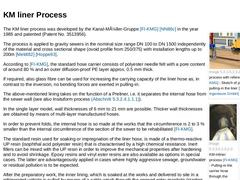
|
|
(Image: KM-Inliner process with reference to [FI-KMG] - Sketch of principle of pulling-in the liner [Image: S&P GmbH])
|
|
(Image: KM-Inliner process [FI-KMG] - Pulling-in the carrier hose through the manhole)
|
|
(Image: KM-Inliner process [FI-KMG] - Pulling-in the carrier hose out of the vehicle with cooling system)
|
The KM liner process was developed by the Kanal-Müller-Gruppe [FI-KMG] [NN86c] in the year 1985 and patented (Patent No. 3513956). The … |
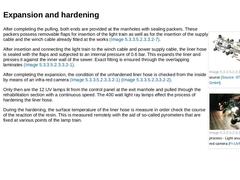
|
|
(Image: Light source)
|
|
(Image: T-Liner process - Light source with infra-red camera [FI-UVRel])
|
After completing the pulling, both ends are provided at the manholes with sealing packers. These packers possess removable flaps for insertion of the light train as well as for the insertion of the supply cable and the winch cable already fitted at the works (Bild 5.3.2.4.1.2.2). After insertion and connecting the light train to the winch cable and power … |
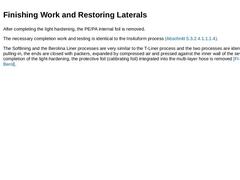
|
After completing the light hardening, the PE/PA internal foil is removed. The necessary completion work and testing is identical to the Insituform process (Abschnitt 5.3.2.4.1.1.1.4). The Softlining and the Berolina Liner processes are very similar to the T-Liner process and the two processes are identical. After pulling-in, the ends are closed with packers, expanded by compressed air and pressed against the inner wall of the sewer. After completion … |
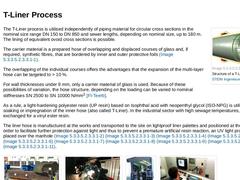
|
(Image: Structure of a T-Liner) The T-Liner process is utilised independently of piping material for circular cross sections in the nominal size range DN 150 to DN 850 and sewer lengths, depending on nominal size, up to 180 m. The lining of equivalent ovoid cross sections is possible. The carrier material is a prepared hose of overlapping and displaced courses of glass and, if required, synthetic fibres, that are bordered by inner and outer protective … |
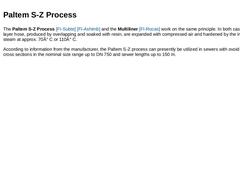
|
The Paltem S-Z Process [FI-Subte] [FI-Ashimb] and the Multiliner [FI-Rocas] work on the same principle. In both cases the multi-layer hose, produced by overlapping and soaked with resin, are expanded with compressed air and hardened by the introduction of steam at approx. 70° C or 110° C. According to information from the manufacturer, the Paltem S-Z process can presently be utilized in sewers with ovoid and circular cross sections in the nominal … |